Things that interest me - Defining my research subjects.
I started the project by creating spider diagrams to explore my interests for each specification given by the brief.
From the diagrams I then defined my main points of interest, these would later form my three research topics;
- Optical Illusions - The idea that the brain can be visually tricked has always been something that interests me. Furthermore, I want to see how optical illusions could be used within design to benefit future projects.
- D.I.Y Culture - The D.I.Y culture is also something that has recently become something I am very interested in, it shares strong links to my craft driven design practice while also having relevance to skateboarding, printing and many other of my interests.
- Skateboarding - Skateboarding is something that has always been important to me, it has been a constant throughout most of my life and is something I am very passionate about. Moreover, not only is skateboarding a creatively expressive sport, but thee associated industry also has very stong links to art & design culture.
RESEARCH TOPIC 1 - OPTICAL ILLUSIONS

I started my research by defining what an optical illusions is;
noun
HISTORY
I researched into the History of Optical Illusions using the book 'The Science of Illusions' by Jacques Ninio.
- An illusions arises when you become aware of a discrepancy. As human beings we see things one way, but know through culture and reasoning that it is not possible.
- Illusions have been noticed and reviewed throughout history since the times of the ancient Greek and Roman Empire.
- Euclid wrote a book called 'Optics' around the year 300BC, in which he formulated laws about the manner of seeing.
- Euclid's laws;
- For a horizon surface located above the eye level, the parts farthest away lookm lower (the floors rise and the ceilings descend).
- An arc of a circle placed on the same plane as the eyes ("seen on the edge") looks rectilinear.
- As the a sphere, the visible part will be smaller, but look larger.
- If a sphere has a diameter less that the distance between the eyes, the viewer will see more of it than a hemisphere.
- Around 1040, Ibn el-Haytham had an important idea that each of the points of a lighted object becomes a source emitting light in all directions.
- Furthermore, through a suitable optical system (a mirror) all the rays coming from a point on an object can be focused on one precise point. His ideas were published in the Kitab el-Manazir, The Book of Visions.
- There were plenty of mistakes in Ibn el-Haytham's work, but these were cleared up by astronomer Johannes Kepler in 1604.
- Kepler aimed to understand the optics of the eye to help him accurately refine astronomical models.
- Kepler proposed that the image is formed on the retina and is then inverted in relation to the external world.
- With help from Kepler, Snell and Descartes, light rays and vision became well understood. This lead to further discoveries regarding the formation of rainbows and the bending of a stick in water.
- In 1666 Edme Mariotte discovered and proved that human vision has a blind spot - 'this is the area of the retina from which the optic nerve leaves.
- Jaques Rohault devoted much of his 1671 'Treatise on Physics' to the five senses, focusing on the geometrical aspect of vision that allow us to estimate the size and distance of an object.
- Rohault was also fascinated by colour perception.
- Rohault proposed the idea that people could be born colour blind.
- At the end of the seventeenth century Philippe de La Hire described colour consistency - 'An object appears the same colour in daylight as it does in candle light.
- In 1743 Buffon described coloured shadows.
- In 1669 Isaac Newton proved that white light is a mixture of all coloured light.
- At the end of the eighteenth centuary, Gaspard Monge had chance to observe some mirages, describing them as a stratification of the atmosphere into horizontal layers where the temperature increases closer to the ground.
- This had the effect of curving the light rays making things appear to be in other than their actual places.
WHY DO THEY OCCUR?
Optical illusions occur as a result of how information is received through the eyes and how that information is interpreted in the brain, this process is otherwise referred to as the visual system. Optical illusions trick the brain creating a false visual impression, proving that seeing is not always believing.
As optical illusions occur this way they have been a point of interest for mathematicians, who use maths to create certain illusions and psychologists who use illusions to help them understand certain workings of the brain.
A more detailed description of how the visual system organizes retinal images can be found in an article written by Donald D. Hoffman.
IMPORTANT POINTS MADE
- The visual system does more than actively transmit images to the brain, it actively takes part in organizing and interpreting them.
- The visual system organises and interprets retinal images because most of what we see can be ambiguous, this is due to the fact that what we see is three-dimensional and retina image is two dimensional.
- To interpret the three dimensional world the visual system uses sophisticated inference without us being consciously aware.
- Therefore, the appearance of depth is inferred by our visual system.
- The visual world obeys certain rules and regularities, the visual system learns these to form a reliable understanding of the external world.
- A study by Shimon Ullman supporting this uses visual motion perception, in which the visual system perceives the correct three dimensional shape and motion from its moving two-dimensional projection.
- Ullman attached small LED lights randomly to a beach-balls surface, then, in a dark room let the ball spin. The visual system has the ability to perceive the correct shape and direction of the object simply by assessing the position of the lights.
- Similar studies have been done supporting this using lights placed on the joints of a human figure, when shown the still images it is hard to derive meaning. However, when the images are set in motion the visual system immediately recognizes the human form despite the lack of appropriate information to do so.
- Its the laws and regularities found in the visual world that are key to the visual systems accurate deciphering of retinal image.
- The face goblet illusion works by utilizing the brains ability to recognize figure. The illusion uses two faces to create the shape of a goblet, both the faces and goblet are recognizable figures which causes the brain to initially see one or the other.
- This allows the brain to interpret multiple figures without the reversal or rotation of the image.
- Vision is an active process, the function of which is to infer an accurate description of an object from changing patterns of light falling onto the retinas.
PERCEPTION

How information is perceived depends also on learned perceptions. For example, people who have spent their lives in a dense forest have difficulty judging distance and size in large open areas like the prairies. They do not realize that objects that are large may appear small because they are far away. Although their vision is sharp, their perception of the world is inaccurate. What they have learned about interpreting the information provided by their senses is incomplete. People's perceptions can be fooled when seeing something that lies outside their previous experience.
When looking at optical illusions, the eyes are recording an image that the brain misinterprets. The brain likes to group things into patterns of familiar forms. It is always comparing things with its experience and knowledge of the world. For example, the brain knows that a bicycle wheel is circular. So even though the wheel may not look circular from a particular angle or perspective, the brain interprets the wheel as circular.

FAMOUS ILLUSIONS
After gaining an understanding of how and why visual illusions occur I started researching into well know optical illusions. I saw examples of these popping up everywhere while collecting my initial research into the history of visual illusions, so thought it an important point to cover.
THE HERMANN GRID ILLUSION
In the Hermann Grid Illusion, the white dots at the center of each square seem to shift from white to gray.

- The Hermann grid was first discovered by a physiologist named Ludimar Hermann in 1870.
- When the viewer looks at the grid, the white dots and the center of each 'corridor' seem to shift between white and gray. When the viewer focused his or her attention on a specific dot, it is obvious that it is white. But as soon as attention is shifted away, the dot shifts to a gray color.
ZOLLNER ILLUSION
In the Zollner illusion the brain is tricked into thinking parallel lines are not parallel and will diverge.

- The Zöllner illusion is another famous optical illusion. First discovered in 1860 by a German astrophysicist named Johann Karl Friedrich Zöllner.
- The illusion presents a series of oblique lines crossed with overlapping short lines. The oblique lines look as if they are crooked and will diverge. In reality, all of the oblique lines are parallel, its easier to see this from a distance.
THE PONZO ILLUSION
In the Ponzo Illusion the brain is confused into thinking that one line is longer than the other.

- The Ponzo Illusion was discovered by Italian psychologist Mario Ponzo in 1911.
- The two yellow lines are the exact same size, but because they are placed over parallel lines that seem to converge in the distance, the top yellow line appears to be longer than the bottom one.
THE KANIZSA TRIANGLE ILLUSION
In the Kanizsa triangle illusion the brain perceives a triangle that is not really there.

- The Kanizsa Triangle illusion was first described in 1955 by an Italian psychologist named Gaetano Kanizsa.
- In the illusion, a white equilateral triangle can be seen in the image even though there is not actually a triangle there. The effect is caused by illusory or subject contours.
THE RUBIN GOBLET ILLUSION
In the Rubin goblet illusion the brain can will initially perceive a drinking goblet or two faces.

- First discovered by Edgar Rubin in 1915.
- In this illusion we can see both a black goblet and two symmetrical white faces, the effect is created using negative space.
VISUAL ILLUSIONS CONTINUED - ROTATING HEADS
I continued my research into optical illusions by researching into some varying types of illusion. The first is one that everyone can relate to, the rotating head illusion.
This form of illusion cleverly adapts the features and aspects of a human head and face to create an image similar to the one shown below. When the image is looked at one way, a face is clearly distinguishable. However, if the image is then flipped, a completely different face can be seen.
This form of illusion cleverly adapts the features and aspects of a human head and face to create an image similar to the one shown below. When the image is looked at one way, a face is clearly distinguishable. However, if the image is then flipped, a completely different face can be seen.
The illustrations below are some of the most well know rotating head illustrations, designed for advertising purposes in the 1930′s by British artist Rex Whistler. He got the idea from some seventeenth century engravings, which had first appeared in 1671 in a book by polemicist Pierre Berault.
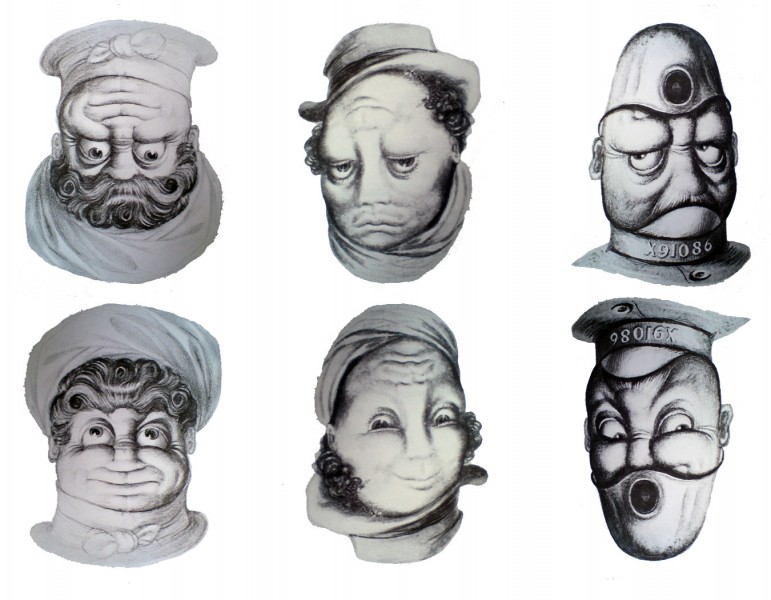
Rex Whistler's inspiration was taken from these seventeenth century engravings.

Another of Whistler's illustrations
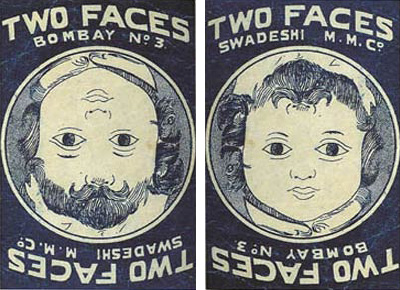
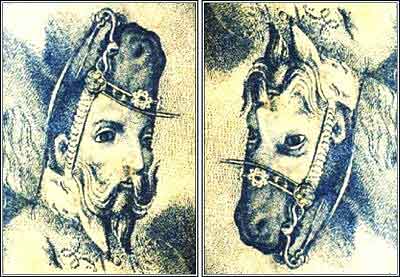
I think that this technique could be adapted to create some really interesting prints. The fact that the portrait can be rotated to create a new image means that the audience have to physically interact with the piece to create something new.
HYBRID PORTRAITS
Hybrid portraits superimpose one portrait on top of another, so that one appears with close viewing, and the other emerges with more distant viewing or with reduced image size.
The technique was invented by Aude Oliva, Antonio Torralba and Philippe G. Schyns, and presented in 2006 at the huge annual Siggraph (electronic graphics) conference.
In the below image this technique is used to turn Charlie Chaplin into Queen Victoria.
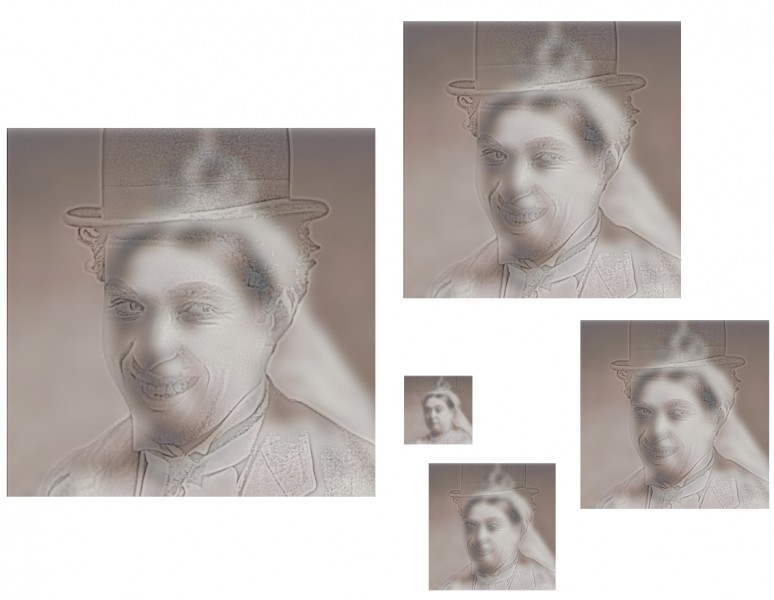
Another good example of a hybrid portrait can be seen below, the image shows Dr. Angry and Mr. Calm. The faces show opposite expressions, however if you move away from the screen the faces swap expressions.

A similar illusion can also seen below, where a jaguar becomes an elephant. However, I don't believe this works as effectively as the visual difference between the two chosen subjects is not as strong.

I believe that this type of illusion could easily be adapted and used in the world of design. Viewers could be tricked into seeing one image from a distance, and then realise the true meaning of the design only when up close to the image.
AMBIGUOUS IMAGES
Information taken from; The Eye Beguiled - Optical Illusions by Bruno Ernst
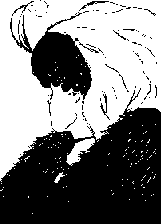







AMBIGUOUS IMAGES
Information taken from; The Eye Beguiled - Optical Illusions by Bruno Ernst
- When an image hits the retina two categories can be distinguished, image information, based on pictographic elements which reproduce the objects present and spatial information composed of stereographic elements which reproduce the spatial relationship between objects.
- The eye processes both the pictographic and stereographic elements into one meaningful interpretation.
- Ambiguous images play on this process by creating an image which can be interpreted in multiple ways.
- We become aware of an ambiguity because we first see on interpretation and then notice the other.
- A good example of a pictographic ambiguity can be found within the famous illusion 'My wife and my mother-in-law' published by cartoonist W.E Hill.
- Some ambiguous figures rely on the angle that the illusion is first seen from.
- The images on our retina are two-dimensional. An important job of the eye is to reconstruct three-dimensional reality from these two-dimensional images.
- This helps us calculate the spatial relationships between objects and ourselves.
- Stereographic ambiguity plays on our perception and knowledge of objects and our environment.








IMPOSSIBLE SHAPES
I continued my research into visual illusions by looking at impossible shapes such as the triangle illusion seen below.
http://www.blifaloo.com/illusions/impossible.php
After further research into the impossible triangle I discovered that it, among a majority of other impossible shapes were created by an artist called Oscar Reutersvärd. Later, in the year 1954 the triangle was redrawn as we know it today by a physicist named Roger Penrose.
Information Link

Information Link

Oscar Reutersvärd
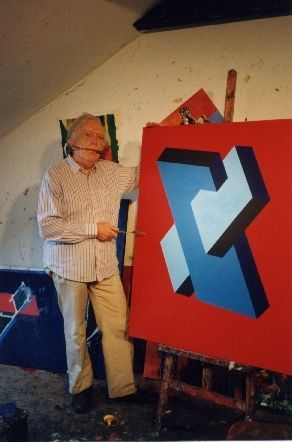
- Born in Stockholm in 1915, professor of Art History and Theory at Lund University, Sweden, founder in 1950 and fellow of the International Association of Art Critics IAAC, fellow of the American Association for Aesthetics and of the Societé de l'Art Francais.
- He is a regular contributor to the American Journal of Aesthetics and Art Criticism, Gazettes des Beaux-Arts and D'ars and has published numerous papers and articles on the utopists of architecture and paintings from the time of the French Revolution and on the abstract sculpture and painting movements of the twentieth century.
- He is a person of myriad interests and talents and is best known for having designed the first and, since then, the largest quantity of impossible figures and simular visual illusions.
The fact that Reutersvärd alone designed almost 2500 impossible figures is very impressive, and in my eyes makes him the king of impossible shapes. Below are some examples of the figures he created.
Below are some modern adaptations of impossible shapes.







TESSELLATION
After looking at various works by Oscar Reutersvärd I came across some intricate tessellation pieces. I noticed that the tessellation techniques was used in a few different illusions so decided to pursue the lead further.
M.C ESCHER
- Maurits C. Escher is a Dutch artist born in 1898.
- One of the worlds most famous graphic artist, regarded as the father of modern tessellation.
- Best known for his tessellation work, impossible structures, and transformation prints.
- His genius lay in his ability to explore mathematical ideas in art.
I also watched this informative documentary about Escher's life and works.
METAMORPHOSIS
When Escher moved away from Italy to Switzerland in 1933 his work began to move away from his initial point of focus of landscapes to graphic works and tilings. The idea of Metamorphosis became one of Escher's favorite themes, experimenting with turning one thing into something else.
Below are some examples of Escher's Metamorphosis experiments, all the examples have been taken from the book 'M.C Escher by Taschen'
The four images below show one of Escher's longest metamorphosis prints.
TESSELLATION
After studying elaborate tile work found in the Alhambra fortress in Spain Escher became fascinated with symmetry and tessellation.
In the late 1930's Escher started to experiment with tessellation, throughout his career Escher numbered all of his tessellations and by his death he had produced 137. Below are some of my favorite examples of his tessellation work.
OPTICAL ILLUSIONS
Around 1959 Escher was given the opportunity to lecture on symmetry to an international group of crystallographers, this brought him and his work closer to mathematics than ever before. Moreover, Escher kept in touch with a handful of scientists who sent him ideas to explore. From this Escher was inspired to create his famous 'Ascending and Descending' stairway.
OPTICAL ILLUSIONS IN PHOTOGRAPHY
To push my research I started looking at other areas in which optical illusions can be created. I noticed a lot of work had been produced through the lens of a camera so decided to investigate this further.BERNARD PRAS
Bernard Pras is a French photographer and installation artist specializing in the creation of large portrait images. Pras creates these images using found objects such as wood and unused clothing, intricately arranging the objects so they form his subject. The image can only be seen from the angle of the photographer as the objects are arranged to its angle of perspective.

An interesting video showing the creation process of one of Pras's pieces can be seen below.
Below are some more examples of visual illusions created within the lens of a camera.






Below are some more examples of visual illusions created within the lens of a camera.






OPTICAL ILLUSIONS IN GRAPHIC DESIGN
Finally, I started looking at the different ways visual illusions are used within the graphic design industry.

Link

Link
ARTIST - TANG YAU HOONG




Tang Yao Hoong
Link

Link
SIMON C. PAGE
Simon Page is a self taught graphic designer and illustrator from England. His two posters (shown below) cleverly use negative space to create a reversible poster showing both a hero and villain.




Simon Page is a self taught graphic designer and illustrator from England. His two posters (shown below) cleverly use negative space to create a reversible poster showing both a hero and villain.




ARTIST - TANG YAU HOONG
Tang Yao Hoong is an Illustrator who creates various visual illusions using techniques such as negative space.




Tang Yao Hoong
Link
Lowe-ssp3
Design agency Lowe-ssp3 created a set of three poster designs for Colsubsidio's "Book Exchange" program. The posters ingeniously use optical illusions to cleverly communicate the projects slogan of 'Come with a story, leave with another'.
























































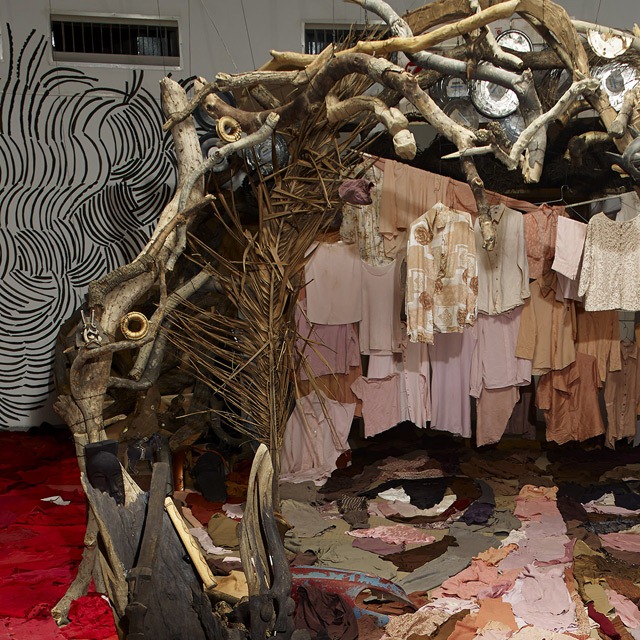
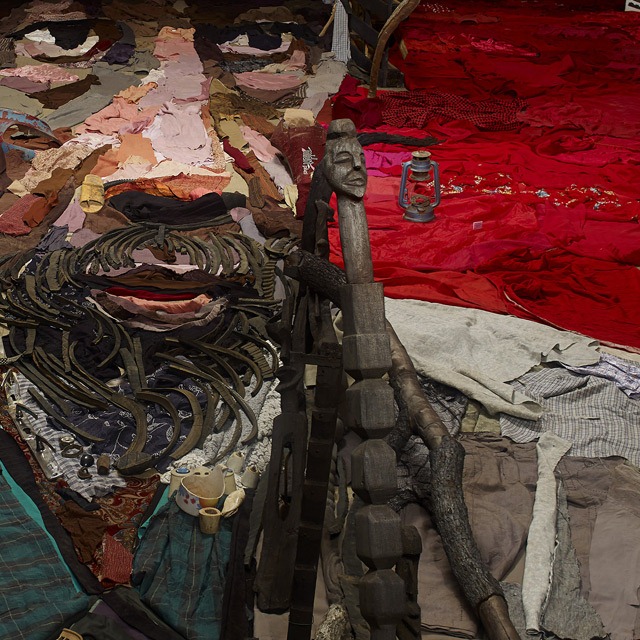

No comments:
Post a Comment